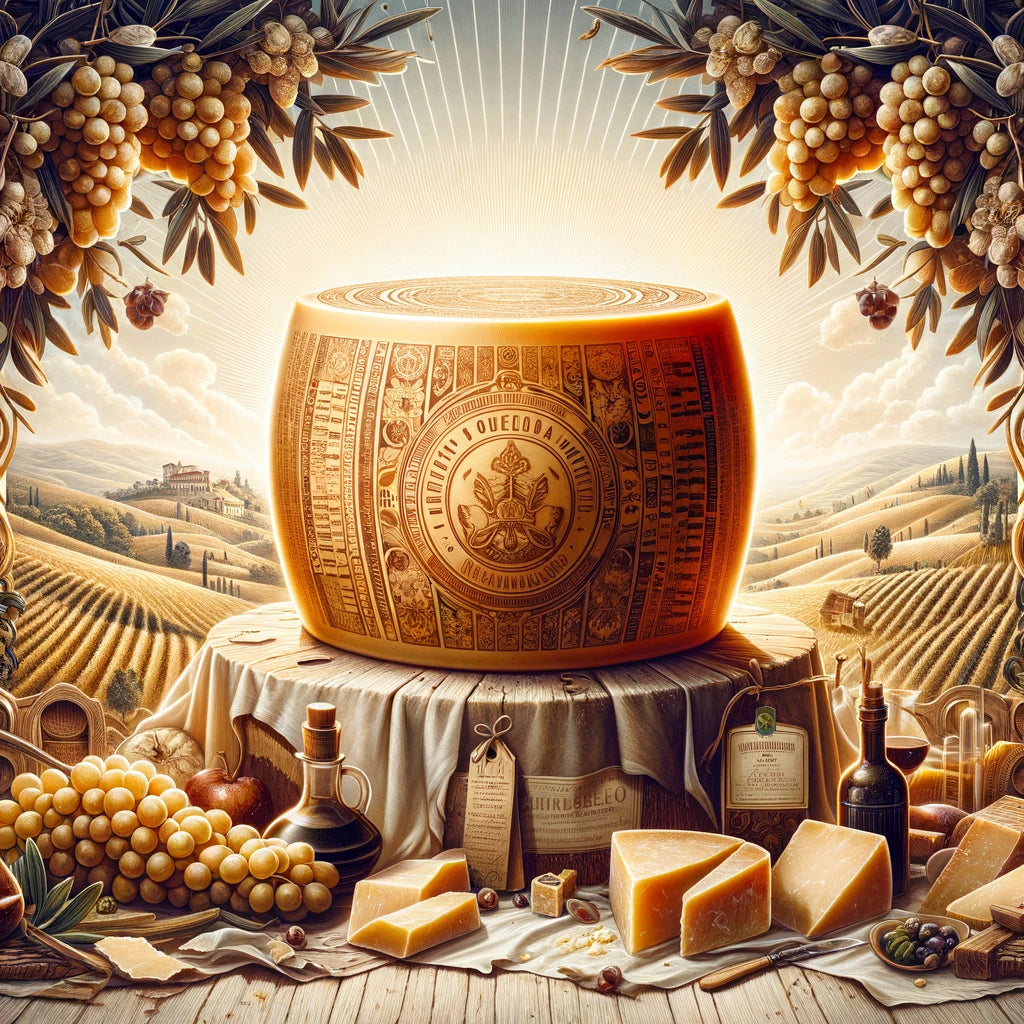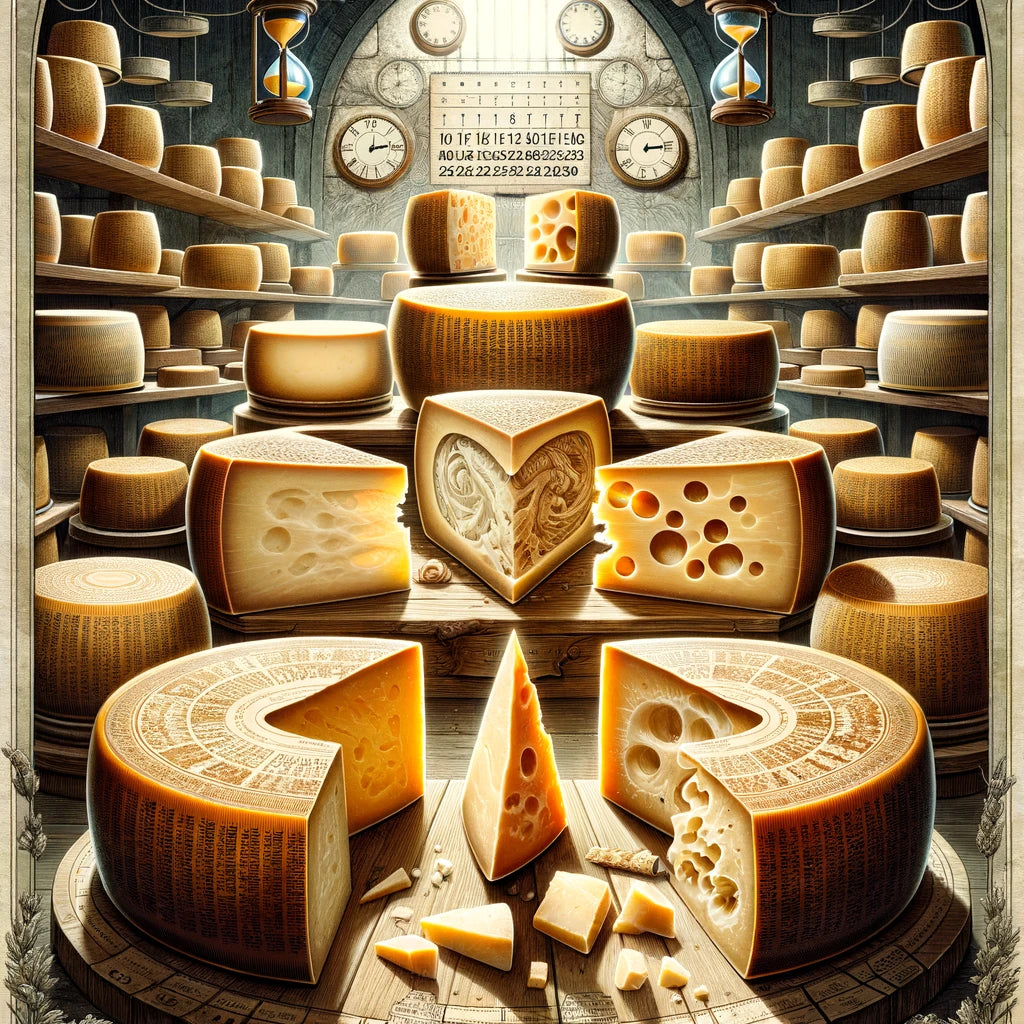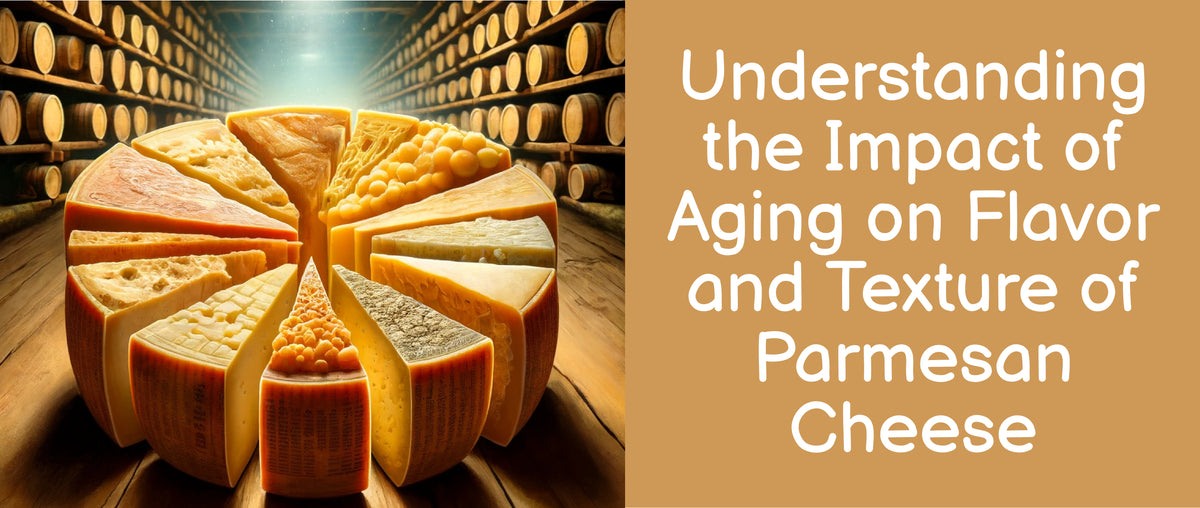Understanding the Impact of Aging on Flavor and Texture of Parmesan Cheese
Parmesan cheese, particularly Parmigiano Reggiano, stands as a pinnacle of culinary excellence, revered for its complex flavor profile and versatile usage in kitchens worldwide. Originating from Italy, this hard, granular cheese is produced using unpasteurized cow's milk, which undergoes a meticulous aging process to achieve its distinct characteristics.
The difference between Parmigiano Reggiano and Grana Padano, another renowned hard Italian cheese, lies in their geographical origin, milk quality, and aging duration. Parmigiano Reggiano, often referred to as the King of Cheeses, is strictly produced in the Parma, Reggio Emilia, Modena, and Bologna areas of Italy. Its production adheres to stringent guidelines that mandate a minimum aging period of 12 months, although the cheese can be aged for over 36 months for a more profound flavor.
Key Takeaways
- Parmesan Cheese Origins and Types: Parmesan, particularly Parmigiano Reggiano, is renowned for its intricate production process, requiring unpasteurized cow's milk and a rigorous aging process, distinguishing it from other cheeses like Grana Padano.
- Ageing Process Importance: The aging process, extending from 12 to over 36 months, is crucial for developing Parmesan's bold flavor, crumbly texture, and nutritional profile, including its transition to becoming lactose-free and concentrating its protein and calcium content.
- Culinary Applications Varied by Age: Parmesan cheese offers a range of flavours and textures based on its age, making it versatile in culinary applications—from being a subtle addition in young forms to a bold, flavour-enhancing component in matured forms.
- Rise of Plant-Based Alternatives: The surge in vegan and plant-based cheese alternatives like vegan Parmesan and mozzarella blocks reflects a broader dietary shift. These products cater to vegans and those with dairy intolerances, using ingredients like nuts and soy to mimic traditional cheese textures and flavors.
- Nutritional Considerations and Choices: Traditional Parmesan is high in proteins, calcium, and vitamins beneficial for health, but it also contains saturated fats and sodium. Vegan cheeses offer lower saturated fat and cholesterol levels but might lack the higher protein and calcium levels of dairy-based cheeses.
- The Balance of Tradition and Innovation: The exploration of Parmesan and its aging process highlights the balance between time-honored traditions and modern dietary trends, celebrating both the rich flavors of traditional cheeses and the innovative approaches of plant-based alternatives.
Vegan Cheese Alternatives
Contrastingly, vegan cheese and plant-based cheese alternatives have emerged, catering to the dietary preferences of vegans and those with dairy intolerances. These products, such as vegan mozzarella cheese block and vegan Parmesan cheese block, strive to replicate the texture and taste of their dairy counterparts using ingredients like nuts, soy, and root vegetables. While they offer a sustainable and inclusive option, the flavor and texture nuances of traditional Parmesan remain unparalleled.

The Art of Aging: How Time Transforms Cheese
Why is Cheese Aged?
Aging, or affinage, is a critical process that transforms the initial mild and soft cheese into a product rich in flavor and with a more firm texture. This process is not merely about time but involves carefully controlled conditions to encourage the development of the cheese's flavor and texture. Aging allows for the evaporation of moisture, concentrating the cheese's flavor, and encouraging the development of a rind.
The Aging Process and Its Impact on Parmesan
Parmigiano Reggiano undergoes an aging process that can last from 12 months to over 36 months. This duration is pivotal in developing its bold flavor, crumbly texture, and the presence of tyrosine crystals, which are hallmarks of well-aged Parmesan. These crystals add a pleasant crunch and are a sign of a high-quality parmesan cheese block.
During the aging process, the cheese's lactose is broken down, rendering it virtually lactose-free, and its proteins decompose into free amino acids, contributing to its umami flavor. This makes Parmesan not only a delight for the palate but also accessible for those with lactose intolerance.
Aged cheeses like Parmesan are often compared to Unprocessed Cheese, which is marketed for its minimal processing and preservation of milk's natural qualities. However, the aging process of Parmesan enhances its nutritional value, concentrating its proteins and calcium while making it a digestible and low fat cheese option for many.
Nutritional Benefits of Aged Parmesan
The aging process of Parmesan not only enhances its flavor and texture but also its nutritional profile. Parmesan is rich in proteins, calcium, and vitamins, making it an excellent addition to a balanced diet. Its high content of essential amino acids contributes to muscle repair and growth, while its calcium content supports bone health. Furthermore, as a low-fat cheese, Parmesan can be a healthier option for those monitoring their fat intake, though it's important to consume it in moderation due to its high sodium levels.
In contrast, the market has seen a rise in vegan items and plant based cheese products, marketed towards those seeking dairy-free alternatives. While these options provide inclusivity for dietary restrictions, they often rely on different nutritional profiles, emphasizing plant-based proteins and fats.
Culinary Applications: Matching Parmesan's Age with Dishes
Parmesan cheese, with its range of aging profiles, offers a spectrum of flavors and textures suited to various culinary applications. The age of the Parmesan significantly influences how it's best utilized in dishes, from a subtle, nutty addition to a bold, flavor-enhancing component.
Young Parmesan (12-18 Months): A Versatile Beginning
Young Parmesan, aged between 12 to 18 months, possesses a mild, slightly nutty flavor with a creamy texture. This mozzarella cheese-like versatility makes it ideal for:
- Shaving over salads for a light, nutty flavor.
- Incorporating into risottos or pastas, where it melts beautifully, adding a subtle depth without overpowering the dish.
Mid-Aged Parmesan (20-30 Months): The Flavor Intensifier
As Parmesan ages to 20-30 months, its flavor becomes more pronounced, offering a balance between sweetness and saltiness. This stage is perfect for:
- Grating over hearty dishes such as soups and stews to enhance their flavor complexity.
- Serving as a table cheese, paired with fruits and nuts for a sophisticated cheese platter.
Mature Parmesan (Over 36 Months): Bold and Beautiful
Mature Parmesan, aged over 36 months, develops an intense, bold flavor with a crumbly texture. Its pronounced taste makes it a star in:
- Finishing touches on gourmet dishes, where its strong flavor can stand out.
- Pairing with wines and aged balsamics for an exquisite tasting experience.

The Rise of Plant-Based Alternatives: A New Culinary Trend
The demand for Vegan Cheese and plant-based cheese alternatives has surged, reflecting a growing dietary shift towards veganism and plant-based diets. These alternatives, including parmesan cheese block and mozzarella cheese block, are crafted from ingredients like cashews, almonds, and coconut oil to mimic the texture and taste of dairy cheese.
While these vegan alternatives offer a sustainable and ethical choice for many, they also present new culinary avenues to explore:
- Vegan Shop now feature a wide array of vegan items, including cheeses that can be used similarly to traditional Parmesan in salads, pastas, and as garnishes.
- Plant-based cheeses are being used innovatively in vegan versions of classic dishes, from pizzas to cheesecakes, broadening the culinary landscape for those adhering to vegan diets.
Nutritional Considerations: A Balancing Act
The choice between traditional Parmesan and its vegan alternatives extends beyond taste preferences to nutritional considerations. Parmesan cheese is renowned for its high protein, calcium, and vitamin content, beneficial for bone health and muscle function. However, it also contains saturated fats and sodium, which should be consumed in moderation.
Conversely, vegan cheeses often boast lower levels of saturated fats and are cholesterol-free, aligning with health-conscious dietary choices. Yet, they may lack the protein and calcium levels found in dairy-based cheeses, necessitating a balanced diet to ensure adequate nutrient intake.
Conclusion
The exploration of Parmesan cheese and its aging process reveals a world where time-honored traditions meet modern dietary trends. Whether opting for the rich, deep flavors of aged Parmesan or embracing the innovative realm of plant-based alternatives, cheese remains a central pillar in the culinary arts. As we continue to explore and appreciate the nuances of both traditional and vegan cheeses, we enrich our palates and culinary experiences, ensuring that the world of cheese continues to evolve and inspire.
In this journey through the aging process of Parmesan cheese, we've uncovered the complexities that make it a staple in gourmet kitchens and dining tables worldwide. The inclusion of plant-based alternatives in this narrative not only acknowledges the evolving dietary landscapes but also celebrates the diversity and innovation in today's culinary practices.








